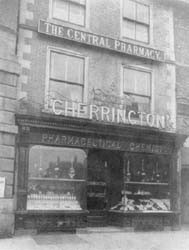Cherringtons

Cherrington's distinctive frontage, 1950s
T. Healey/Picturethepast.org.uk
The location of Cherringtons the Chemist in Newark Market Place
Rich Mixtures at the Chemists
By Tim Warner
The first record we have of a chemist in the Cherrington building dates from 1780 when the tenant was a George Stevenson, “Druggist.” At that time (and indeed until as recently as the 1920s) the building was part of the Duke of Newcastle’s estate and Stevenson paid an annual rent of £120.
The Caparn Years
It is not known precisely when Stevenson ceased trading, but by 1809 Newark ’s trade directories had begun listing Thomas Caparn as a new tenant of the building. It would appear likely that Caparn had been Stevenson’s apprentice and, as was the custom, had taken over the business following Stevenson’s death.
Once in possession the Caparn family became fully entrenched in the pharmaceutical business, as successive generations of the family held the tenancy for the next 44 years. They apparently passed the business from father to son, and a high point was reached in 1837 (the year of Queen Victoria ’s accession to the throne) when William John Caparn acquired the business in addition to having the good fortune of being Mayor of Newark for that year.
During his time in the building, William John Caparn is believed to have lived over the shop, while the cellar area beneath was reserved for the servants and kitchens. The 1841 census shows no fewer than eight people living in the building, which, beside Caparn and his wife, comprised four assistants (or live-in apprentices) and two female house servants.
Despite being married, however, William John Caparn (the third successive generation of his family to occupy the building) left no heir, and in 1851 the business passed to a 29-year-old bachelor from Stowe in Lincolnshire , William March.
William March Arrives
March had served his apprenticeship in Stamford and afterwards gained experience in Paris and Boulogne . Returning to England he became an assistant in an important establishment in the West End of London where he used to dispense medicines for the Duke of Wellington (the ‘Iron Duke’). Following the death of William John Caparn, March bought the tenancy of the shop in Newark and moved in.
In 1882 he took on another Lincolnshire man as his apprentice, a former veterinary surgeon from Stamford called George Cherrington. Five years later, in 1887, March retired through ill health and the business passed into the sole proprietorship of Cherrington. The firm of G.W.Cherrington was born.
Cherrington Takes Over
George Cherrington managed his affairs well and the business began to flourish, becoming an integral part of Newark life. In keeping with tradition, he made apprentices of his two sons, and, in the course of time, they eventually came to succeed him at the helm.
When, however, it was their turn to retire in 1949, no direct successor was available, and a company was formed to buy the business from them. Trading under the name of Cherrington & Sons it was this company which saw the business through its final years from 1949 to 1993.
During the time the business was held by the Cherringtons the shop saw many changes – the distinctively decorated sign was erected, while inside trading was extended and diversified; the capacious cellars beneath shop were converted to house barrels of port and sherry which customers could buy over the counter siphoned off into their own bottles; meanwhile in a warehouse further down Chain Lane (now subsumed by the Royal Exchange development) the Cherringtons manufactured their own soda and mineral waters. And it was here too that other, less likely substances were also prepared.
At one time the Cherringtons marketed their own paint and distemper, while a profitable sideline was carried on in manufacturing veterinary preparations such as sheep dip, and horse powders, the latter being mixed with spades on the floor of the warehouse. In the early years of this century Cherrington’s was also one of the few places where Newark ’s pioneering motorists could obtain their petrol.
With such a long and distinguished history of uninterrupted pharmaceutical trading on the site, the loss of Cherrington’s will be felt strongly by many who value the character and amenity of Newark’s grand old market place.